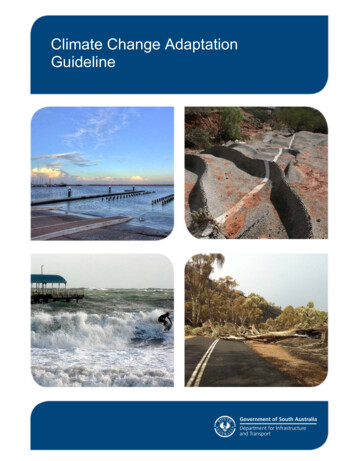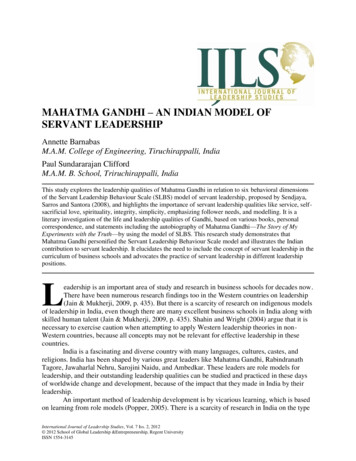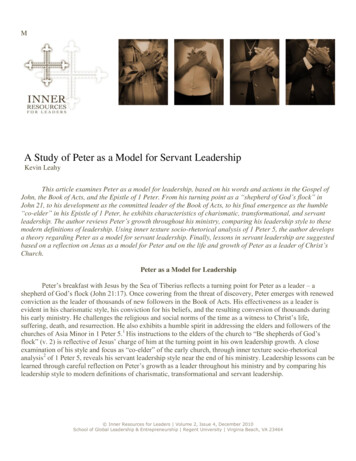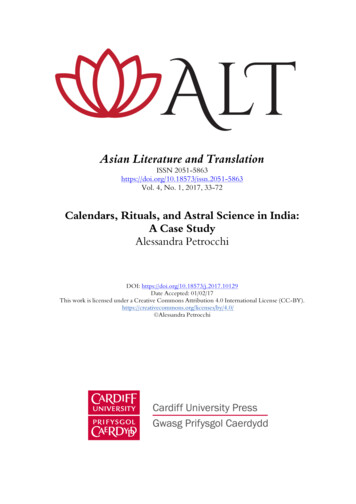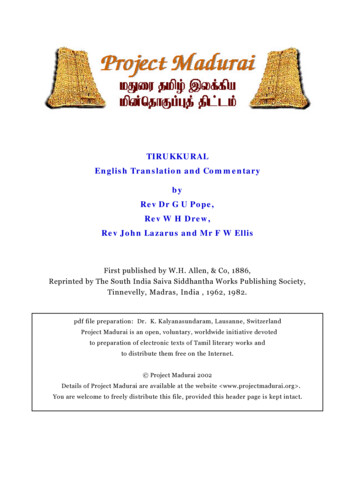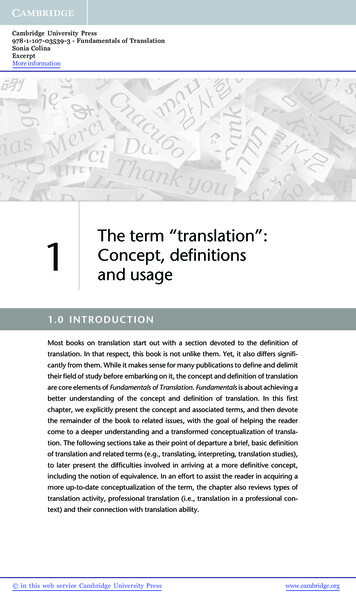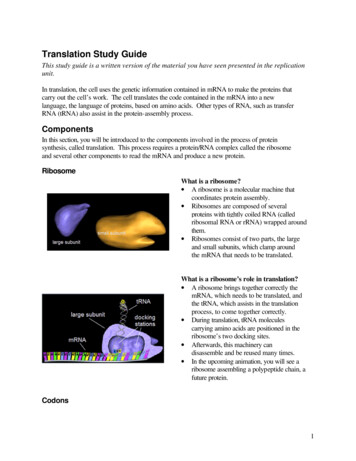
Transcription
The 10th International Days of Statistics and Economics, Prague, September 8-10, 2016TRANSLATION AND ADAPTATION OF SERVANTLEADERSHIP QUESTIONNAIRE INTO CZECH LANGUAGEJana Kolářová – Pavlína Honsová – Michal KonvalinkaAbstractPlenty of leadership theories have emerged as our environment has been rapidly evolving interms of social, technological, economical, political and ecological changes. Servantleadership is distinguished from prior theories by its follower-centric premise which is guidedby a set sequence of choices: to serve first, then to aspire to lead (Greenleaf, 1970). Servantleadership is an exception within new leadership models having passed the test of showingincremental validity after controlling for transformational leadership and leader-memberexchange (Liden, Wayne, Zhao, & Henderson, 2008). This study is focused on the process oftranslation and adaptation of a 28-item servant leadership scale developed by Liden et al.(2008) into the Czech language. Firstly, the scale was independently translated twice intoCzech and the back-translation was compared to the original scale. Secondly, pilot interviewswere carried out in order to ensure sufficient comprehension of the translation. Finally,an expert group evaluated the outcomes of the previous steps and created a final version of theitems in the Czech language. The translated questionnaires were administered to 192 studentsof a bachelor programme at University of Economics, Prague. Finally, a statistical analysiswas carried out.Key words: servant leadership, questionnaire, translation, adaptationJEL Code: C83, D23, M14IntroductionThis paper aims to anchor a new leadership theory within the context of the Czech Republic.After such corporate scandals as Enron or Lehman Brothers emerged, ethics and corporatesocial responsibility became more important in business schools’ curricula and also ina development of leadership theories. Ghoshal (2005) criticizes development of new courseswithout having reviewed old theories, e. g. corporate governance or transaction costeconomics. He argues that such theories and ideas subsequently legitimize the managementpractices that cause amoral behaviour. Given that our region has already been struck many882
The 10th International Days of Statistics and Economics, Prague, September 8-10, 2016times by corporate scandals (e. g. Volkswagen’s manipulation of emissions), we perceivean introduction of servant leadership to the Czech environment as beneficial in order to givean alternative approach to the usual leadership theories.First of all, this paper provides a theoretical background of servant leadership withan overview of its current operationalisation and measurement methods. Secondly, methodsused to adapt the chosen servant leadership questionnaire are described. Finally, the resultsare both presented and discussed.1Theoretical backgroundServant leadership challenges conventional beliefs about leadership (Northouse, 2015) byputting followers first to serve them in their personal growth. The term was coined inGreenleaf’s (1970) seminal work. It might be an answer to a call to address 21st century issueswith its emphasis on a service to others (Parris & Peachey, 2013). Liden, Panaccio, Hu &Meuser (2014) note that servant leadership was overlooked by the academic community untilthe 2000s. In view of the current changes towards process models of leadership, rather thanfocusing on a person or a position, authors offer a comprehensive theoretical model with suchcomponents as creating value for the community or behaving ethically. Despite manytheoretical and empirical studies, servant leadership suffers from the same lack of consensusabout its definition and the theoretical framework as the field of leadership theories(van Dierendonck, 2011). The distinction from other leadership theories (e. g.transformational leadership, LMX theory) lies also in a leader’s responsibility towards a widerrange of organizational stakeholders and the emphasis on moral principles (Ehrhart, 2004).There are several strengths of servant leadership. Sound psychometric measures areavailable (Liden, Panaccio, Hu & Meuser, 2014). It is investigated across a variety ofcontexts, cultures, and themes (Parris & Peachey, 2013). Several organizations have alreadyused it as a guiding philosophy (Sendjaya & Sarros, 2002), e. g. Southwest Airlines. On theother hand, there are also weaknesses. Its paradoxical name might diminish the potential valueof the theory, it has an utopian ring and could be perceived as moralistic (Northouse, 2015).Servant leaders might face several challenges such as role conflicts, high levels of emotionallabour or manipulation by more savvy followers (Liden, Panaccio, Hu & Meuser, 2014).883
The 10th International Days of Statistics and Economics, Prague, September 8-10, 20161.1Current operationalisationsMulti-dimensional operationalisations were utilized by many authors (Winston & Fields,2015). Given little consensus in a definition of the servant leadership construct, there arevarious descriptions and formulations, e. g. voluntary subordination, authentic self, covenantalrelationship, responsible morality, transcendent spirituality, transforming influence (Sendjaya& Sarros, 2002); wisdom, persuasion mapping, organizational stewardship, altruistic calling,emotional healing (Barbuto & Wheeler, 2006); creating value for the community, conceptualskills, empowering, helping subordinates grow and succeed, putting subordinates first,emotional healing, behaving ethically (Liden et al., 2008).Winston & Fields (2015) criticize the usage of numerous dimensions as problematic interms of their application ambiguity, inclusion of behaviours and attributes similar to otherleadership theories and possibility of follower perceptions’ reflection. Thus the authorspropose an essential set of leader behaviours in order to clarify the loci and mechanisms ofservant leadership. Such an approach may be truly beneficial to the development of servantleaders, however, this paper further focuses on a promising model by Liden, Panaccio, Hu &Meuser (2014). It provides us with a core construct, which is more carefully defined.1.2Measurement methodsA synthesis of 39 appropriate empirical studies, based on a systematic literature review,revealed that researchers are using multiple measures to explore servant leadership (Parris &Peachey, 2013). Previously presented operationalisations are further developed mainly intoinstruments with a reliability and validity tested. Questionnaires have a different number ofitems, e. g. 10 items (Winston & Fields, 2015), 23 items (Barbuto & Wheeler, 2006); 28 items(Liden et al., 2008) or 35 items (Sendjaya & Sarros, 2002). The measurement strategy forservant leadership theory is still not agreed on (Parris & Peachey, 2013).This study gives a priority to a 28-item measure developed by Liden et al. (2008), latersupported by an advanced theoretical model (Liden, Panaccio, Hu & Meuser, 2014). Themeasure was developed after a literature review was carried out, where 9 dimensions wereidentified. Afterwards, an exploratory factor analysis of the pilot study revealed 7 distinctdimensions. Phase 1 consisted of a pilot test of 85 servant leadership items with a studentsample of 298 individuals. Phase 2 involved a confirmatory factor analysis using anorganizational sample of 182 individuals. Authors validated their 28-item measurement whichpassed the test of showing incremental validity after controlling for leader-member exchange884
The 10th International Days of Statistics and Economics, Prague, September 8-10, 2016and transformational leadership. Furthermore, Liden et al. (2015) developed a 7-item measureof global servant leadership based on previous 28-item servant leadership measure.2MethodsOur methodology consisted of two stages. In the first stage, translation and adaptation ofa questionnaire was carried out. Secondly, a pilot study was conducted. Subsequently,a statistical analysis was carried out.2.1Translation and adaptationThe translation and adaptation of the questionnaire was designed based on Procházka,Kulhavý, & Jirásek (2015). Two researchers translated the questionnaire independently andthen discussed the differences in order to create one version in Czech. It was presented toa third researcher with experience in professional translations and with a limited priorknowledge of the servant leadership theory. A back-translation into English revealed thedifferences between the original items and the first translation. Changes in translation in theselected items were proposed.Following discussion of all the three researchers was aimed to create a semi-finalversion of the translation. Items of creating value for the community were particularlydifficult to agree on given the context of the Czech Republic where such activities are not sowidespread and the word “community” has a specific connotation with an alternative orcommunity treatment (such as psychotherapeutical). In order to ensure an appropriateadaptation, six pilot interviews were conducted in order to reveal how different individualsmight react to our translation. Responses were obtained from 6 working adults. An attentionwas paid to their diversity, therefore their selection was determined by the gender, educationand age. The sample consisted of 3 females (age group 20 – 35 and 51 – 65 with universityeducation, 36 – 50 with high school education) and 3 males (age group 20 – 35 and 51 – 65with high school education, 36 – 50 with university education). After the interviews, a nextmeeting of the three researchers was held in order to prepare a final version of thequestionnaire for a pilot study. The items of creating value for the community proved again tobe more difficult to understand.Likert scale was used with response options from 1 (strongly agree) to 5 (stronglydisagree). Liden et al. (2008) used a scale from 1 (strongly disagree) to 7 (strongly agree) for885
The 10th International Days of Statistics and Economics, Prague, September 8-10, 2016both the student and organizational surveys. We decided to use less detailed scale in order tonarrow down respondents’ possibility of choice.2.2Pilot studyIn the second phase, we conducted a pilot test of the 28-item servant leadership questionnairewith a student sample. The version of the questionnaire which was filled by the participantscan be found in the attachment of this paper. The data were collected from undergraduatestudents of a bachelor programme Business Administration at University of Economics,Prague. We selected subject Psychology and sociology in management due to its connectionto our topic and a convenient number of 240 active students. Majority (98 %) were in thesecond year of their studies with almost equal distribution of female (52 %) and male (48 %)students. The responses were obtained from 192 students out of which 10 questionnaires hadto be eliminated because of missing values. The final number of respondents is 182.The lecturer of the seminar introduced the study. Each respondent was asked to reply toeach item based on his or her experience with a specific leader. Participation was voluntarywith an option to withhold. The students completed the questionnaire during the time of theirseminar.3ResultsThe data collected in the second phase of our study were subjected to a basic statisticalanalysis. Table 1 shows its results. There was a great deal of items exceeding the skewness of0.5 and the kurtosis values as well. We determined items to be too difficult when exceeding0.9 and too easy when not reaching 0.1 based on Říčan (1977). None of the items showedinappropriate values, yet item 11 was the closest to the borderline. We determined thecorrelation with the raw score not to be lower than 0.2. Item 16 showed a correlation, whichwas too low. The reliability of our measurements was determined by computing Cronbach salfa (0.913), which showed a sufficient value.Item 11 “My manager has a thorough understanding of our organization and itsgoals.” seems to us very problematic given its median 1.00, item difficulty 0.16 and verypositive skewness value of 1.35 and kurtosis value 2.25.886
The 10th International Days of Statistics and Economics, Prague, September 8-10, 2016Tab. 1: Descriptive statisticsItemMSDMedian SkewnessKurtosisItemDifficultyCorrelationwith raw rce: Authors1.073.00-0.01-0.620.490.684DiscussionThe results show that the Czech version of the questionnaire provides reliable information,however there are some problematic items to be discussed further. The process of a backtranslation, a discussion, pilot interviews and again a discussion of our team helped us tocreate a quality Czech version for the pilot study. The main decisions during those twodiscussions were concerned with cultural and vocabulary adaptations. Specifically, items 5, 6,7, 8 related to the factor Creating value for the community, were difficult to translate. Weused four different translations for the word community, based on our understanding of itemsand mainly based on the Czech environment. On the other
Key words: servant leadership, questionnaire, translation, adaptation JEL Code: C83, D23, M14 Introduction This paper aims to anchor a new leadership theory within the context of the Czech Republic. After such corporate scandals as Enron or Lehman Brothers emerged, ethics and corporate social responsibility became more important in business schools’ curricula and also in a development of .File Size: 852KBPage Count: 11
